
5 AI Book Translation Services Tested: From Free Google Hacks to Premium Solutions
Want to translate a book but unsure which AI service to trust? Here's a quick breakdown:
We tested 5 popular AI book translation tools to see how they perform in accuracy, formatting, language support, pricing, and speed. Whether you're an author, publisher, or casual reader, this guide will help you choose the right tool for your needs.
- BookTranslator.ai: Best for preserving book formatting and style, with pricing at $5.99 per 100,000 words. Supports over 50 languages, but limited to EPUB files under 50MB.
- Google Translate: Free and supports 130+ languages. Great for simple, quick translations but struggles with complex texts and formatting.
- DeepL: Offers high-quality translations for 31 languages, especially European ones. Retains formatting better than Google but has a smaller language range.
- Smartling: Tailored for enterprise users, offering human translations and advanced formatting tools. Pricing is custom, making it better for large-scale projects.
- Taia: Combines AI speed with human accuracy, supporting over 100 languages. Pricing starts at $0.002 per word for AI-only, with higher costs for human-reviewed translations.
Quick Comparison:
| Service | Translation Accuracy | Formatting Preservation | Language Support | Starting Price | Turnaround Time |
|---|---|---|---|---|---|
| BookTranslator.ai | High | Excellent for EPUB | 50+ languages | $5.99/100k words | Minutes |
| Google Translate | Basic to Good | None | 130+ languages | Free | Immediate |
| DeepL | Excellent | Limited | 31 languages | Free (limited) | Immediate |
| Smartling | Very High | Good | 150+ languages | Custom pricing | Variable |
| Taia | Excellent | Excellent | 100+ languages | $0.002/word (AI-only) | Minutes to 24 hours |
Each tool has strengths and limitations. For quick, no-cost translations, Google Translate is sufficient. If you need professional quality and preserved formatting, BookTranslator.ai or Taia are better options. For enterprise needs, Smartling delivers advanced features, while DeepL excels in nuanced translations for European languages.
Your choice depends on your priorities - speed, cost, or precision.
Top 5 machine (AI) translation software you should try | Accuracy comparison & use cases
1. BookTranslator.ai
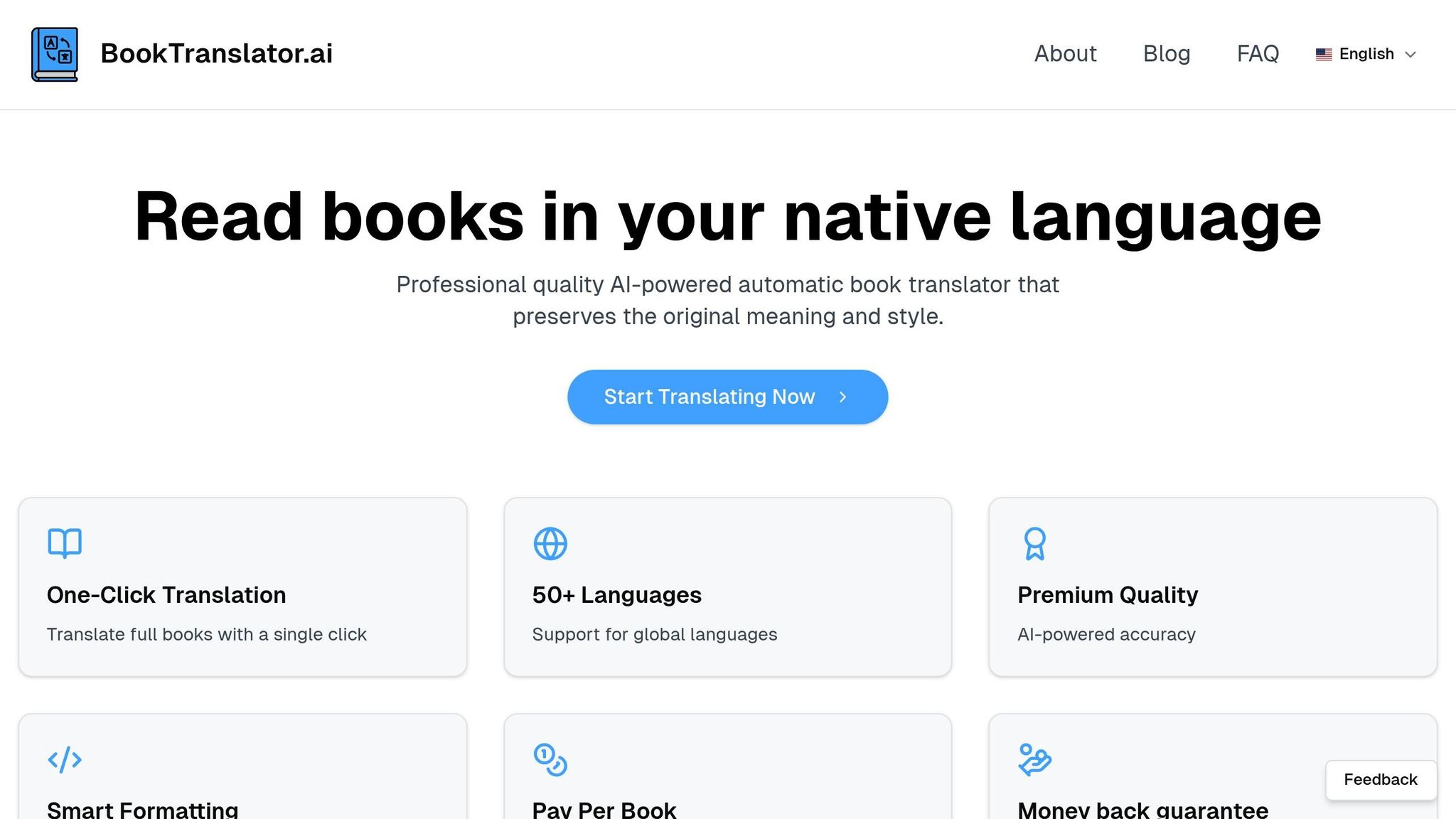
BookTranslator.ai is a specialized AI-powered service designed specifically for translating books. It focuses on maintaining the literary essence, contextual accuracy, and formatting precision required for full-length works. This ensures that both the style and structure of the original text are faithfully represented in the translation.
Translation Accuracy
When it comes to accuracy, BookTranslator.ai delivers impressive results. Reviews highlight that English-to-Catalan translations reach a 95% accuracy rate, while Croatian translations maintain the original meaning and flow. French-to-English translations are also praised for retaining subtle nuances, making the output feel natural and authentic - qualities that are especially important for authors and publishers [1].
Formatting Preservation
One of the standout features of BookTranslator.ai is its ability to preserve the original formatting of books. This includes chapter divisions and complex layouts, which are often crucial for certain genres or styles. For example, a user noted that a German translation of a Spanish book retained all intricate formatting details, including chapter structures. The platform also supports EPUB files up to 50MB, making it a reliable choice for handling large, professionally formatted texts [1].
Language Support
BookTranslator.ai supports a broad range of over 50 languages, covering both widely spoken and regional languages. This includes options like Catalan, Swahili, English, Spanish, Chinese, Russian, French, Thai, Hindi, Italian, Finnish, Korean, Vietnamese, Indonesian, and Japanese. Additionally, it offers dependable reverse translations, showcasing its versatility and commitment to serving diverse linguistic needs [1].
Pricing
The platform uses a straightforward pay-per-book pricing model. The Basic plan costs $5.99 per 100,000 words, while the Pro plan - designed for more complex literary or technical texts - costs $9.99 per 100,000 words. A minimum charge of $5.99 applies to all projects. The Pro tier uses advanced AI models for improved accuracy, making it ideal for challenging translations. Plus, a money-back guarantee provides added peace of mind for users.
Turnaround Time
Speed is another key strength of BookTranslator.ai. Users report quick processing times for single or multiple documents, even for languages like Chinese, Korean, and Japanese. This feature is particularly valuable for publishers working under tight deadlines or readers eagerly awaiting translated works [1]. These capabilities make BookTranslator.ai a strong contender in the world of AI-driven book translation services.
2. Google Translate
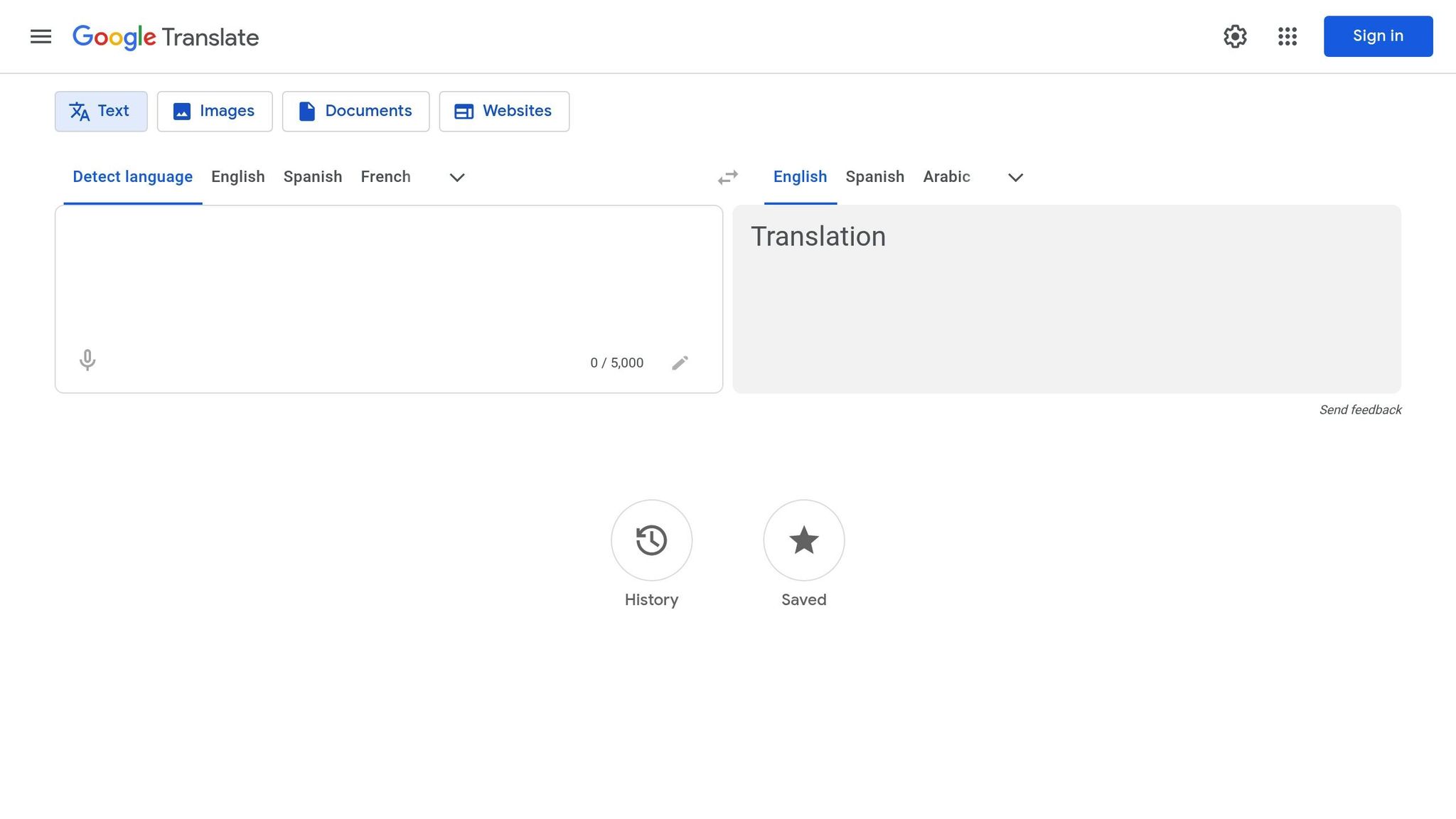
Google Translate is a go-to tool for quick and free translations. While it’s not specifically designed for translating books, its popularity highlights its convenience for fast text conversions. Let’s dive into how it performs in terms of accuracy, formatting, language options, cost, and speed.
Translation Accuracy
When it comes to accuracy, Google Translate performs well for simple, straightforward text in commonly used languages. It can handle basic narratives but tends to stumble with more complex elements like literary metaphors, cultural references, or nuanced dialogue. Since it processes text in short segments rather than as a continuous flow, maintaining context in longer passages can be tricky. This often results in errors or inconsistencies, especially with details like character names or recurring themes.
Formatting Preservation
A major drawback of Google Translate is its inability to retain the original formatting of lengthy documents. Chapter breaks, spacing, and text styling are often lost during translation, leaving users to manually reformat the content afterward.
Language Support
One of Google Translate’s strengths is its extensive language coverage, with support for over 130 languages, including many that are less commonly used. It allows users to translate via direct text input or by uploading documents, though there are limitations on file sizes for the document translation feature.
Pricing
The platform is free to use through its web interface. However, if you need API access via the Google Cloud Translation API, costs are calculated based on the number of characters processed.
Turnaround Time
Speed is one of Google Translate’s standout features. Text translations happen almost instantly, and document uploads are processed quickly. However, the need for manual reformatting after translation can add extra time to the overall process.
3. DeepL
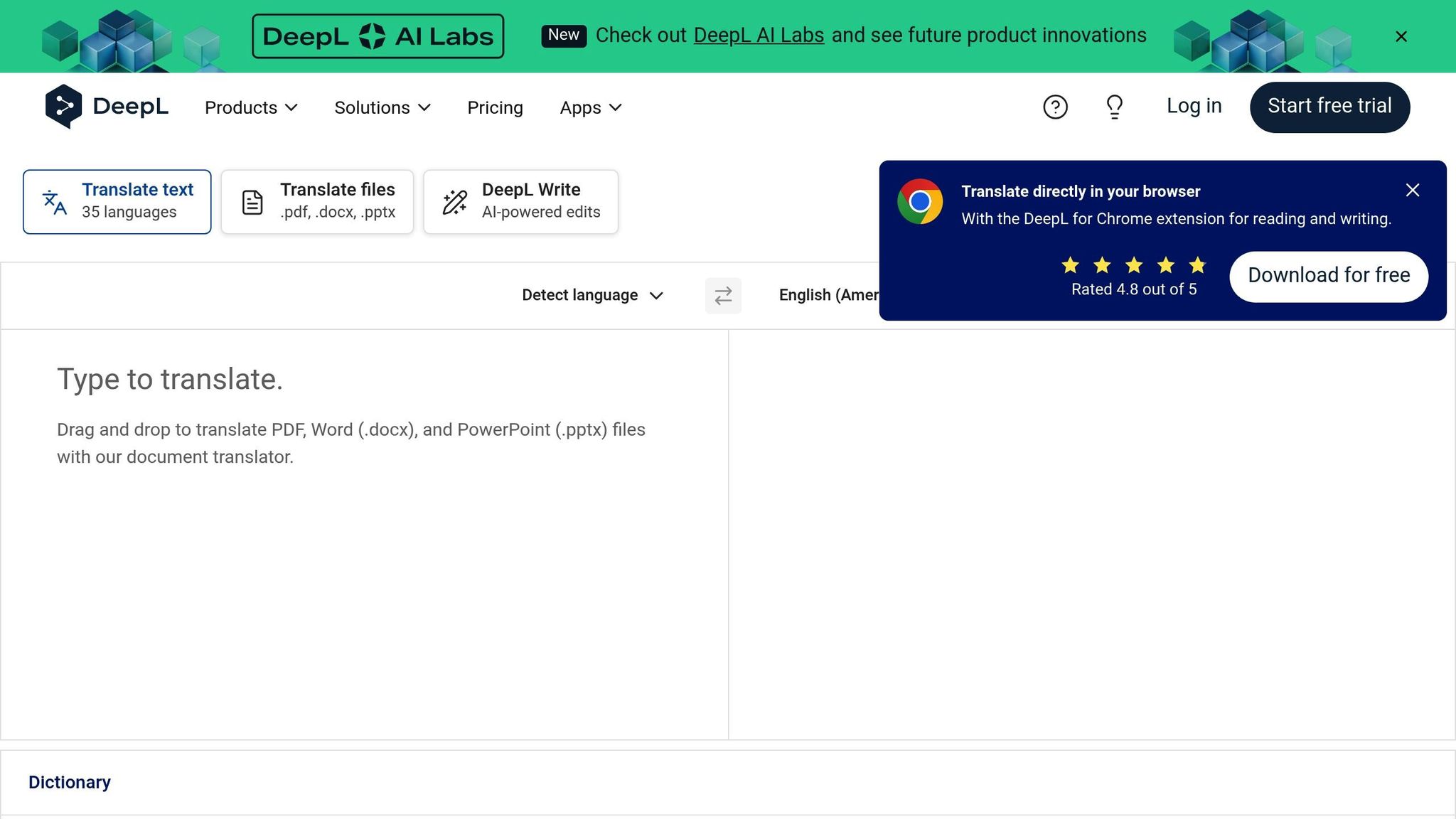
DeepL has broadened its horizons, now covering languages beyond Europe, while maintaining its reputation for high-quality translations.
Formatting Preservation
One of DeepL's standout features is its ability to keep the original document's formatting intact. This includes elements like chapter headings, footnotes, and text alignment - even in PDF files [3]. Additionally, it allows users to convert PDFs into editable DOCX files for further adjustments. However, due to differences in word length between languages, the layout might shift slightly during the process [2].
If you're working with PDF documents, it's best to stick to files with fewer visual elements. This is because DeepL relies on OCR technology to process PDFs, which can sometimes struggle with intricate layouts, leading to errors [3].
Language Support
DeepL currently supports translations for 31 core languages, along with specific variations such as American and British English, Brazilian and European Portuguese, and simplified and traditional Chinese [4][5]. Recent updates have introduced Hebrew, Vietnamese, Latin American Spanish, and Thai, thanks to its advanced language model [4].
That said, there are some limitations. Thai is not available for file translations, and languages like Hebrew, Latin American Spanish, Thai, and Vietnamese can only be accessed via the text API. This makes them unsuitable for translating documents like books [4][5].
sbb-itb-0c0385d
4. Smartling
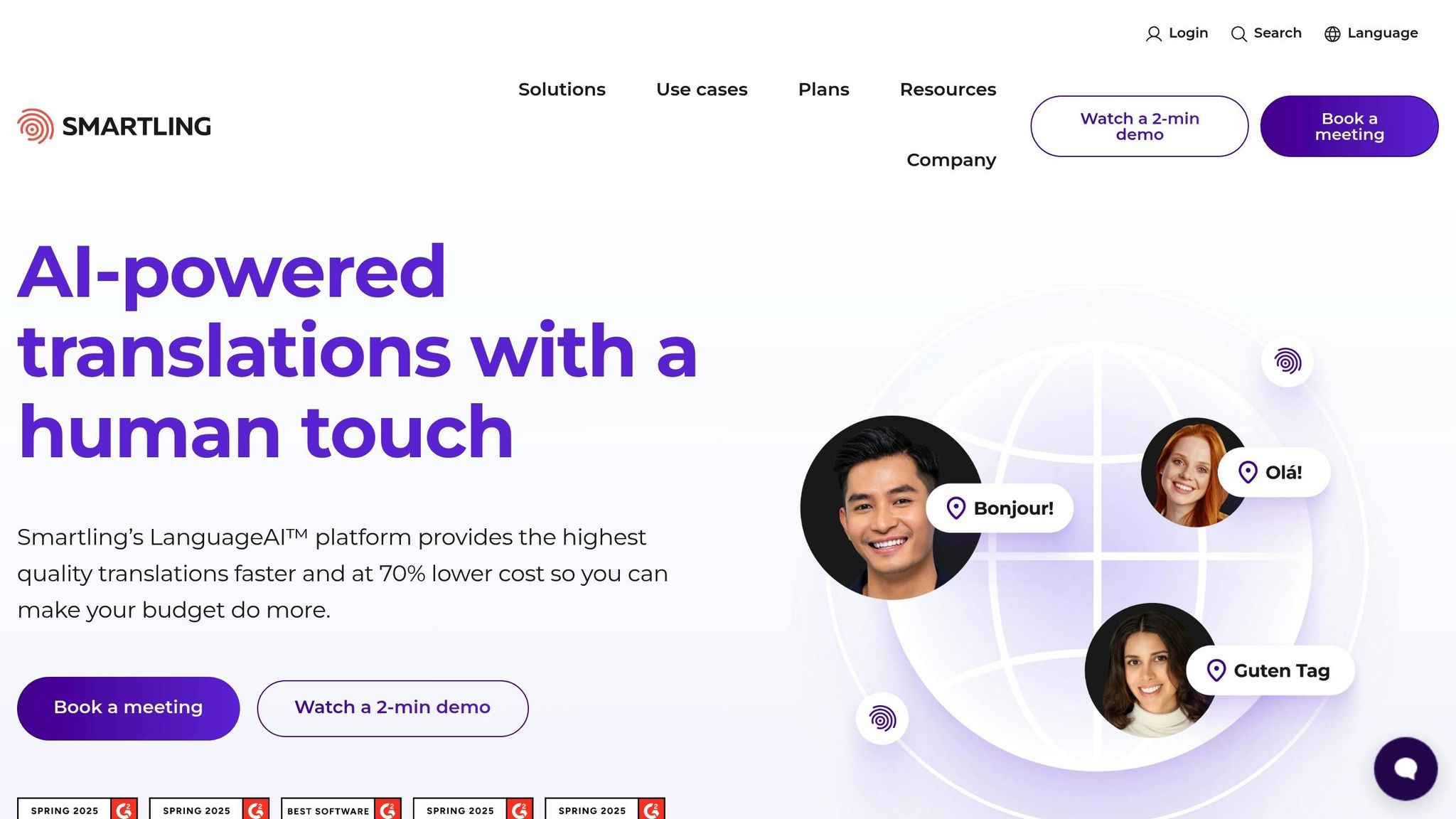
Smartling offers a tailored approach to book translation, focusing on enterprise-level solutions that prioritize precise formatting. The result? A well-structured DOCX output that closely mirrors the original document.
Formatting Preservation
When you upload a PDF to Smartling, it converts the file into a DOCX format. For native PDFs, the platform does an impressive job preserving elements like headings, titles, lists, paragraphs, and tables to match the original layout. However, if you're working with scanned PDFs processed through OCR, the output is simplified into basic paragraphs. It's worth noting that text embedded within images is not translated.
To ensure translators have a clear understanding of the document's layout, Smartling allows you to upload the original PDF as a visual reference or as a job attachment. This visual context helps translators maintain consistency with the source material. For the best results, it's recommended to use native source files, such as Word or InDesign documents, whenever possible. [6]
Language Support
Smartling supports a broad range of languages, making it a versatile choice for book translation. The platform covers major global languages, including several European options, Asian languages like Chinese and Japanese, and even various regional dialects. [6]
Turnaround Time
Unlike instant AI translation tools, Smartling operates on a project-based model that connects clients with professional human translators. This manual approach takes more time but often delivers higher-quality translations, particularly for literary works that require attention to cultural nuances.
For PDF documents, some post-translation formatting - known as Desktop Publishing (DTP) - may be necessary to ensure the final layout looks polished. This step can add a bit of extra time to the process. Similarly, for Markdown files, while Smartling strives to maintain the original layout, some post-processing might still be needed to perfect the appearance. [6][7]
This methodical approach contrasts with the speed of AI-driven solutions but offers a more thorough and nuanced translation, especially for projects where quality and formatting are critical.
5. Taia
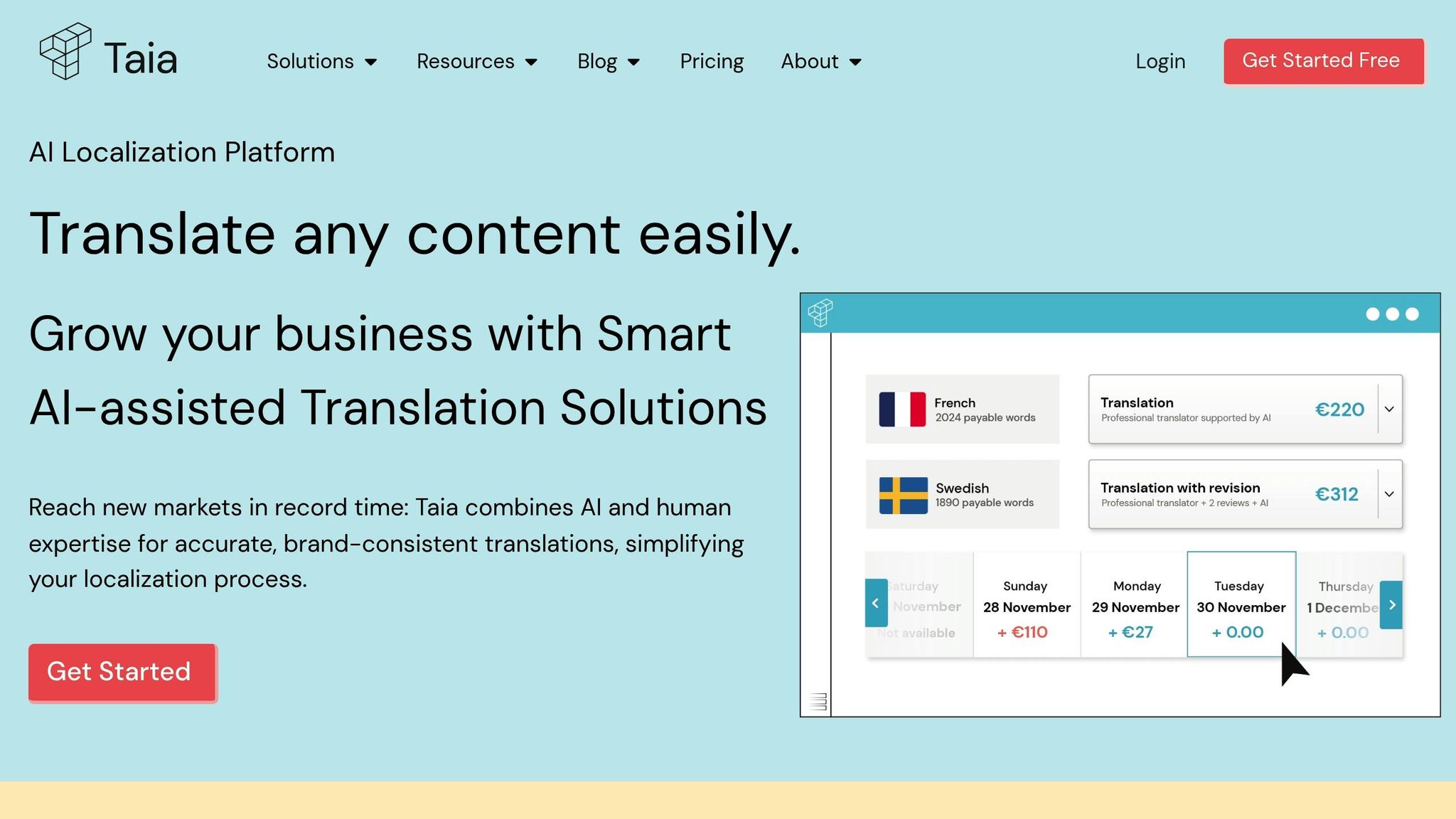
Taia blends the speed of AI with the precision of human expertise, offering both automated and professional translation services tailored for book projects. Like other platforms we've reviewed, Taia is evaluated based on its accuracy, ability to preserve formatting, and overall usability for book translation. One feature that sets it apart is its ISO 17100:2015 certification, which guarantees compliance with international quality standards for translation services.
Translation Accuracy
Taia begins with AI-only machine translation to create quick drafts, but it also offers human-reviewed services for higher accuracy. The basic human translation tier ensures professional-grade results, while premium options include thorough revisions and full proofreading. The platform boasts a 99.4% client satisfaction rate[9], with consistent praise across its service levels. Florian Lehmann from Red Bull shared his perspective on using Taia since 2019:
"We are using Taia for all our translations from German into English and French since 2019 and have been positively surprised from the beginning. Our texts are used for product explanation, advertisement and official contracts with clients. Taia has always delivered in a fast pace, with the highest quality, to an incredibly fair pricing." [8]
Up next, let’s see how Taia handles the layout of your book during translation.
Formatting Preservation
When it comes to keeping your book’s structure intact, Taia does a fantastic job. It supports over 70 file formats, including DOCX, PDF, PPTX, XLSX, IDML, and HTML. This capability ensures that the original layout, chapter breaks, and visual hierarchy of your book remain untouched during the translation process. Whether you're using professional services or self-translation tools, Taia ensures your book’s design elements stay consistent.
Language Support
Taia offers professional translation services in over 100 languages, covering widely used ones like English, Spanish, German, French, Chinese, Arabic, Japanese, and Russian. Its self-translation feature supports 97 languages, while other sources mention over 200 languages available across its various service tiers.
Pricing
Taia uses a straightforward word-based pricing system, starting at $0.002 per word for AI-only machine translations. This makes it an economical choice for generating quick drafts or translating content for casual reading.
For professional human translations, pricing is as follows:
- Basic human translation: $0.09 per word
- Translation with revision: $0.12 per word
- Fully reviewed and proofread: $0.14 per word
The platform also offers cost savings through Translation Memory, which lowers costs for repeated content - especially helpful for book series or related projects.
Turnaround Time
Taia provides flexible delivery options depending on the service level you choose. AI-powered translations are completed within minutes, perfect for quick references or initial drafts.
For human translations, projects under 3,500 words are usually delivered within 24 hours. With a 99% on-time delivery rate[8], Taia also offers expedited options for urgent needs. Users can adjust delivery dates to balance speed and quality. Kate Gross, Manager at Fixthephoto.com, shared her thoughts on the platform’s customization:
"My experience with Taia was positive. I benefited from their services when I needed to translate docs and articles from a photography blog into Spanish. The process was intuitive and I was impressed with its high customizability. I could select the delivery time, and translation quality, and provide special requirements with just several clicks. The ability to customize the workflow to my specific needs increased my productivity." [8]
Pros and Cons Summary
Each translation service brings its own strengths in areas like accuracy, formatting, language options, pricing, and speed, catering to different user needs.
BookTranslator.ai is a solid choice for translating EPUB books while maintaining their original formatting and style. At $5.99 per 100,000 words, it offers competitive pricing and a simple one-click translation process. However, its focus on EPUB format and a file size limit of 50MB may be restrictive for larger projects or users requiring other formats.
Google Translate stands out for being free and supporting over 130 languages, making it accessible for quick translations. That said, it struggles with complex literary texts and doesn't retain book layouts or formatting.
DeepL delivers excellent translation quality, particularly for European languages, thanks to its context-aware capabilities. While its language range is narrower than some competitors, it offers a free basic tier. Advanced features, however, come at a higher cost.
Smartling is geared toward enterprise users, offering advanced project management tools, strong collaboration features, and detailed analytics. While ideal for large-scale operations, its custom pricing may be too steep for individual users.
Taia combines the speed of AI with human expertise to improve translation quality. This hybrid approach makes it a strong option for those prioritizing accuracy, though it comes with higher costs and potentially longer turnaround times.
| Service | Translation Accuracy | Formatting Preservation | Language Support | Starting Price | Turnaround Time |
|---|---|---|---|---|---|
| BookTranslator.ai | High | Excellent for EPUB | 99+ languages | $5.99/100k words | Minutes |
| Google Translate | Basic to Good | None | 130+ languages | Free | Immediate |
| DeepL | Excellent | Limited | 30+ languages | Free (limited) | Immediate |
| Smartling | Very High | Good | 150+ languages | Custom pricing | Variable |
| Taia | Excellent | Excellent | 100+ languages | Custom pricing | Minutes to 24 hours |
This breakdown shows how each service fits different needs. Google Translate is ideal for casual users who need quick, free translations. Authors focused on preserving formatting might lean toward BookTranslator.ai, while those requiring human-reviewed translations could consider Taia, despite its higher cost and slower delivery.
Final Recommendations
Selecting the right AI book translation service comes down to your priorities - whether it's speed, cost, or precision. Different platforms cater to different needs, as testing has shown.
Casual readers looking for quick, no-frills translations will find Google Translate to be the most convenient option. It’s free, supports over 130 languages, and provides instant results, making it perfect for basic reading without worrying about formatting or advanced accuracy.
For those on a budget who still want quality translations, BookTranslator.ai is a standout choice. At $5.99 per 100,000 words, it offers impressive translation quality while maintaining EPUB formatting - something Google Translate doesn’t handle. Its straightforward one-click process and money-back guarantee make it an affordable yet reliable option for those who want professional results without overspending.
Professional publishers and authors with more complex needs should consider DeepL. Known for its context-aware translations, it excels with nuanced texts, especially in European languages. For large-scale projects requiring teamwork and robust tools, Smartling provides enterprise-level features and collaboration options, though its custom pricing may be better suited for organizations with bigger budgets.
For users who prioritize top-tier accuracy, Taia offers a hybrid model that combines AI efficiency with human oversight. This ensures exceptional results, though its custom pricing and variable timelines require careful planning.
Each service has a specific audience, from casual readers to those involved in high-stakes publishing. For most users, BookTranslator.ai strikes the best balance between affordability, quality, and formatting support. While its 50MB file limit might not work for every project, it handles standard book translations effectively.
Ultimately, your choice should align with your primary goal. Quick and basic translations lean toward Google Translate, while more serious reading or publishing needs call for the specialized features of paid services.
FAQs
What should I look for when selecting an AI-powered book translation service?
When selecting an AI-powered book translation service, it's crucial to prioritize translation accuracy and language support. These features ensure the service can handle your project effectively. Tools like translation memory, glossaries, and style guides are particularly helpful for maintaining consistency and delivering polished, high-quality translations across your entire book.
It's also worth evaluating the scalability of the service, its pricing structure, and whether it has expertise in your specific genre or industry. These elements can help you choose a solution that aligns with both your project requirements and your budget. If you're aiming for professional publication, opt for tools specifically designed to deliver precise and refined translations.
How do pricing models for AI translation tools affect the cost of translating a book?
AI translation tools often operate on per-word or per-character pricing models, which can make translating a book far more affordable - sometimes cutting costs by 60% to 90% compared to traditional human translation services. This approach is particularly economical for larger projects, like translating full-length books.
Additionally, many providers offer flexible payment plans, such as pay-as-you-go or usage-based options. These allow you to adjust expenses according to your specific requirements, making AI-driven translations an appealing choice for both individual readers and publishers seeking cost-efficient solutions.
What types of books or content are better suited for human-reviewed translations instead of AI-only solutions?
Books and materials that demand precision, cultural awareness, or expert knowledge - like legal documents, medical texts, or culturally rich literature - are typically better handled by human translators. Humans can carefully preserve tone and context, ensuring the content is accurate and resonates appropriately with its intended audience.
Meanwhile, AI translations shine when it comes to general, time-sensitive, or high-volume tasks where absolute precision isn't as vital. That said, for professional or sensitive work, having human oversight ensures the translation remains high-quality and respects both cultural and contextual subtleties.